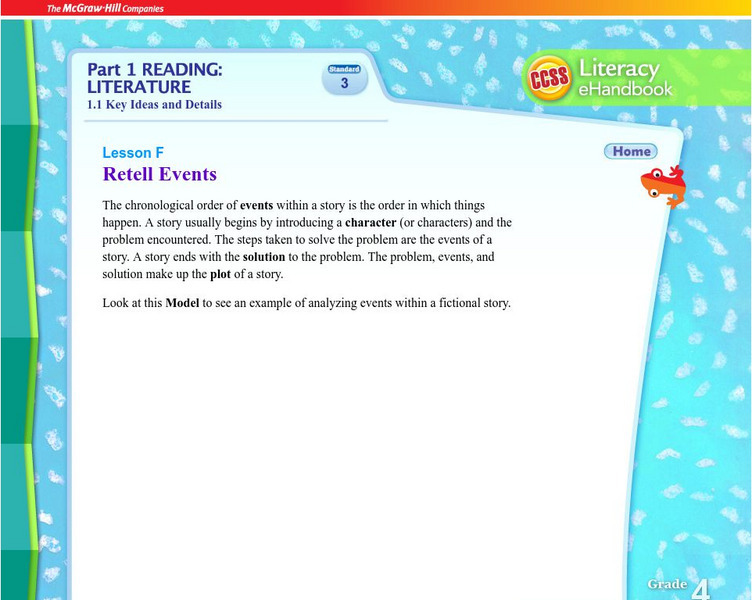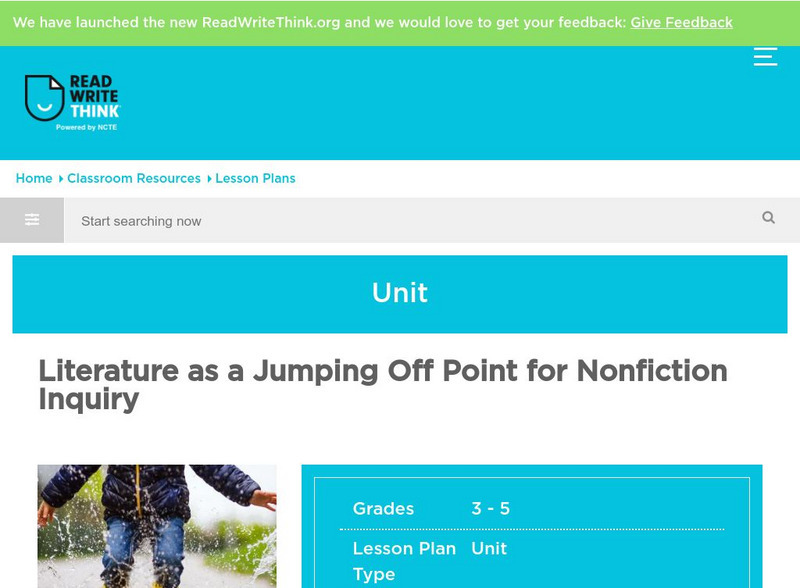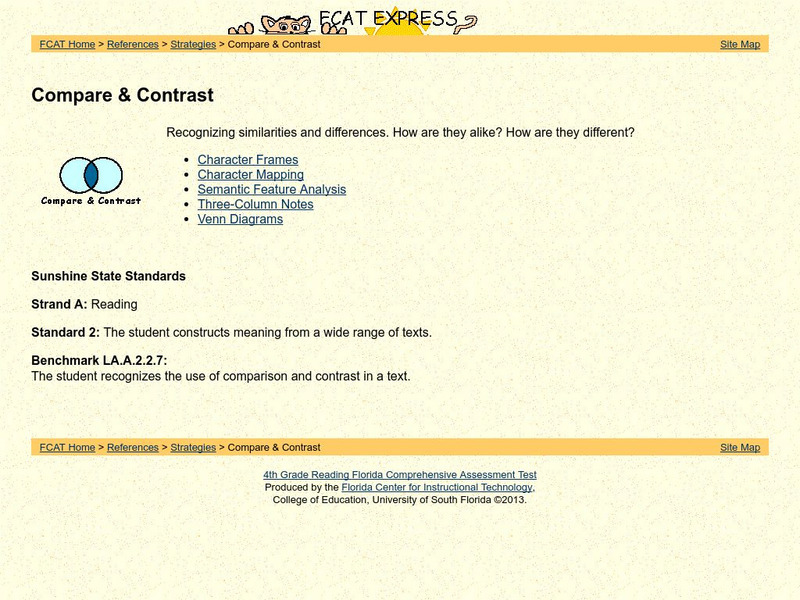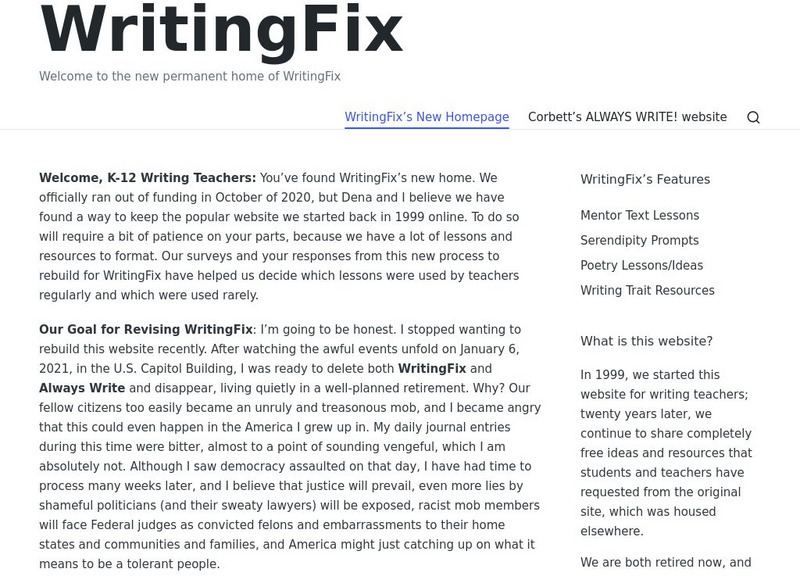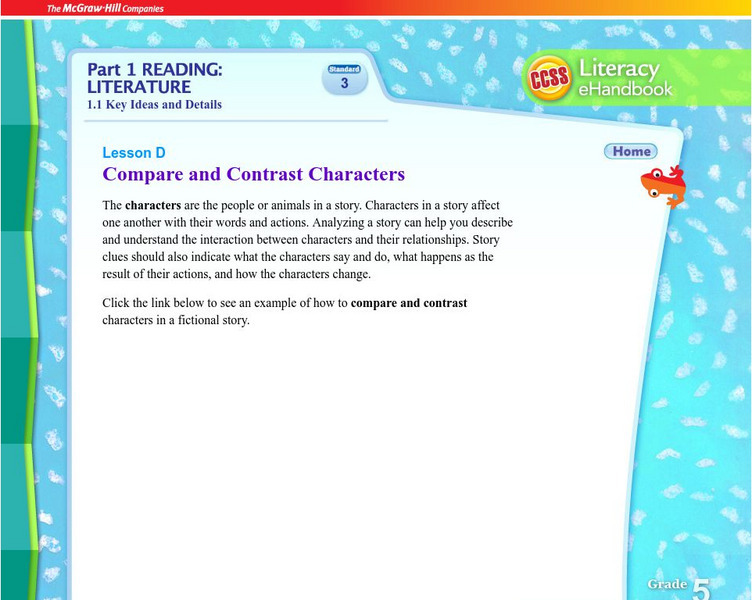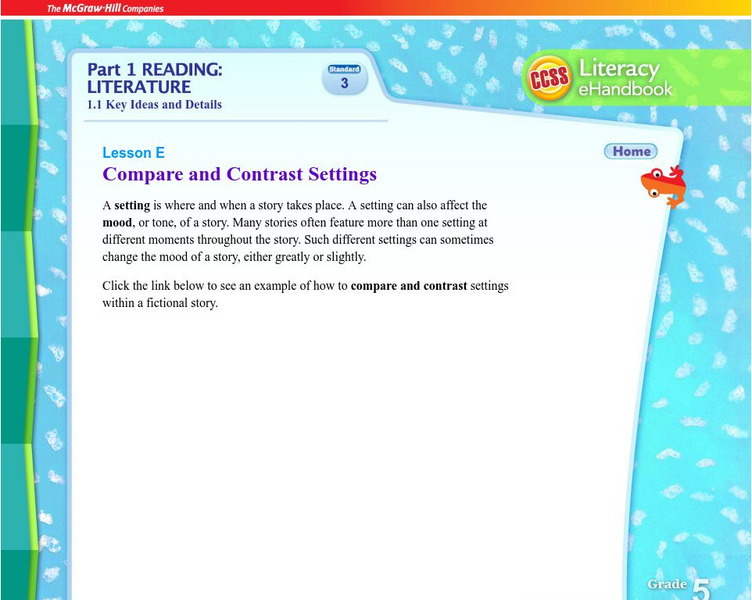Curated OER
Mc Graw Hill: Part 2 Reading: Informational Text: Connections Within Text
Learn how information in a text can be connected through compare and contrast, cause and effect, and sequence.
Curated OER
Mc Graw Hill: Part 1 Reading Literature: Folktale
Understand how to read and find the message the exist in a story. Learn how folktales include messages in their stories.
Curated OER
Mc Graw Hill: 4th Grade Use Details and Examples
When reading a story learn how to recall specific examples from the text to answer comprehension questions. In addition, you can also use story details to make inferences.
Curated OER
Mc Graw Hill: Part 1 Reading: Literature: Describe Characters
A reference guide on how to analyze characters in a story.
Curated OER
Mc Graw Hill: Part 1 Reading: Literature: Describe a Setting
Do you know how to find the setting of a story? Learn how to find the when and where a story took place on this site.
Curated OER
Mc Graw Hill: Part 1 Reading: Literature: Retell Events
Retelling a story shows a student's comprehension. Use this site to test your knowledge of how to retell events that happen in a story.
Curated OER
Mc Graw Hill: Structure Within Prose
Read an excerpt from the story "The Turkey Maiden" to learn about the different elements then practice on your own.
McGraw Hill
Mc Graw Hill:informational Text: Analyze Development of Text Elements:individuals
Read an informational piece, and learn how to analyze the development of individuals in the text. Includes practice exercises.
Other
Interacting Texts Directed Activities Related to Texts (Darts)
Want to improve your students' reading skills? This is a good place to find the types of directed activities, using a definition text, reconstruction/analysis activities, and advantages of using DARTs.
ReadWriteThink
Read Write Think: Book Report Alternative: Examine Story Elements Using Comic Stri
Comic frames are traditionally used to illustrate a story in a short, concise format. In this lesson, students use a six-paneled comic strip frame to create a story map, summarizing a book or story that they have read. Each panel retells...
ReadWriteThink
Read Write Think: Planning Story Characters Using Interactive Trading Cards
Students use trading cards to examine fictional characters in a story.
ReadWriteThink
Read Write Think: Flying to Freedom: Tar Beach & the People Could Fly
Comparing and contrasting works and looking for underlying themes and messages are at the heart of this multicultural lesson plan. Provides links to several background resources, and suggestions for assessment.
ReadWriteThink
Read Write Think: Literature in Nonfiction Inquiry
This lesson plan involves students working in groups after reading a work of literature to develop text sets. Included in the lesson plan is an overview, practice, objectives, resources, preparation, and more.
ReadWriteThink
Read Write Think: Using Picture Books to Teach Characterization
Contains plans for two or three lessons that ask students to examine characterization in picture books to use as models for their own writing. In addition to objectives and standards, this instructional plan contains links to sites used...
ReadWriteThink
Read Write Think: Zines for Kids Multigenre Texts About Media Icons
Contains plans for nine lessons that ask students to create multigenre zines for popular culture figures that include letter, persuasive, narrative, acrostic poetry, comic, and biography/autobiography writing. To accomplish this,...
ReadWriteThink
Read Write Think: Writing Abc Books to Enhance Reading Comprehension
Contains plans for four lessons that are adaptable to many texts that students may be reading. Students analyze the text for literary elements such as characters, setting, figures of speech, and themes, and then publish their findings in...
Quia
Quia: Elements of Literature: Rags to Riches
Answer the 15 questions in this game about literary elements for the prize of fame and fortune. Java is required.
Other
Georgia Perimeter: Choosing and Writing for an Audience
This resource goes extensively into the importance of establishing an audience when writing. It also defines types, how to choose, and how to write for an audience.
John F. Kennedy Center
The Kennedy Center: Arts Edge: What a Character!
For this lesson, students analyze how a character's personality traits, actions, and motives influence the plot of a story. Students also learn how storytellers use their face, body, and voice, as well as the five senses, to enhance the...
University of South Florida
Fcat Express: Compare & Contrast
Strategies to help students recognize similarities and differences provided by a standardized test preparation site intended for fourth grade. Includes strategies such as Character Frames, Character Mapping, Semantic Feature Analysis,...
Writing Fix
Writing Fix: Actions Speak Louder Than Words
After hearing and discussing an excerpt from Sharon Creech's Walk Two Moons, students will plan to create a unique description of a character that uses memorable actions that "show" a person's character. They will brainstorm verbs that...
Curated OER
Mc Graw Hill: Part 2 Reading: Comparison and Contrast Text Structure
A reference article showing reading strategies to understand text structure of comparison and contrast.
Curated OER
Mc Graw Hill: Part 1 Reading: Literature: Compare and Contrast Characters
Learn how to compare and contrast characters on this site. Understand how comparing and contrasting characters is important for reading comprehension.
Curated OER
Mc Graw Hill: Part 1 Reading: Literature: Compare and Contrast Settings
To comprehend a story, students need to be able to compare and contrast the setting. Learn how to compare and contrast setting in this reference article.






